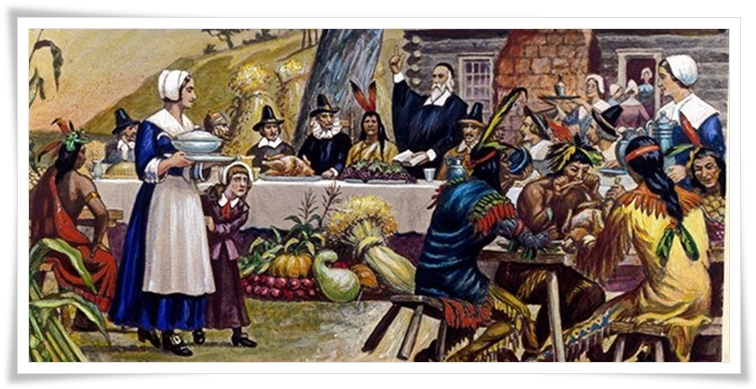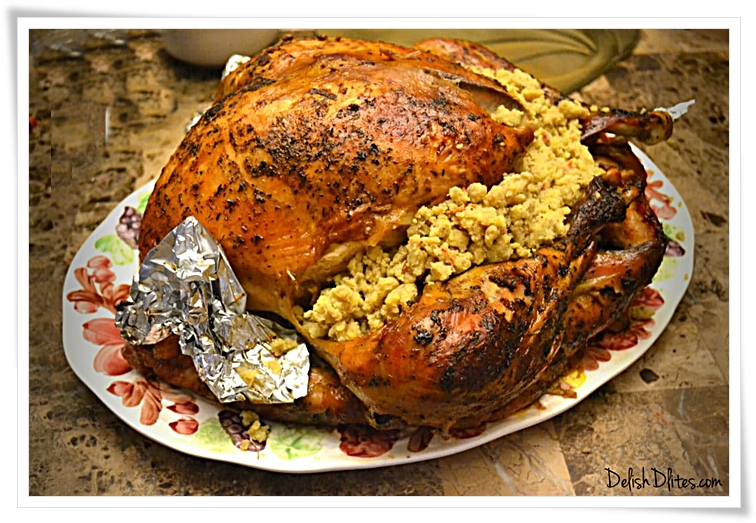
I’m from Connecticut — one of the original thirteen colonies and neighboring state to the birthplace of Thanksgiving, Plymouth Massachusetts. When I first moved to the island, I thought it would be impossible to shake New England Thanksgiving traditions. But over the years and through the abundant generosity and amazing culinary skills of my Puerto Rican friends, I’ve learned to love what I first hated about Puerto Rican Thanksgiving.
As a U.S. territory, Thanksgiving is a well-celebrated holiday throughout the island, but with a unique Caribbean twist to the menu. Combining classic American Thanksgiving traditions with flavors from Puerto Rico’s Latin American heritage, you get spice-enhanced favorites like pavo (turkey), pernil (roast pork), mofongo stuffing (made with fried and mashed green plantains, garlic, and crunchy pieces of fried pork rinds called chicharrón), arroz con gandules (rice with pigeon peas), amarillos (fried sweet plantains), morcilla (blood sausage) tostones (fried smashed plantains), and tembleque (coconut custard) or dulce de leche (a moist milk cake).
What you won’t get: sweet potato casseroles, canned cranberry sauce (does anybody really like that?), mashed potatoes and gravy, and sadly, not homemade pie. You can buy pies at American chain stores like Sam’s and Walmart. But is a Walmart apple pie comparable to a good old fashioned Granny Smith apple pie straight out of an American oven? No, not at all. I’d make my own, as I do have an oven, but frozen pie crusts are hard to find around here and I’m too lazy to make my own from scratch. So, Walmart apple pie topped with ice cream is my one hold-out to American traditionalism. Even after all these years, I have not developed a taste for tembleque.
On the other hand, I LOVE the spiced up, flavorful meats served on this festive day. Just as the rest of the U.S., the centerpiece to any Puerto Rican Thanksgiving meal is the turkey … or as they call it here, Pavochón. The word is completely made up, combining the Spanish words for turkey (pavo) and roast suckling pig (lechón).

No matter the etymology of Pavochón, one thing is certain; it’s mouth-wateringly good. From a once die-hard American turkey traditionalist, believe me, there’s no better way to prepare your Thanksgiving bird. Spice up your holiday and try something different this Thanksgiving. Make your turkey Puerto Rican style. Here’s a great recipe (Courtesy of Delish D’Lites).
Pavochón: Thanksgiving Turkey Puerto Rican Style
Prep Time: 2 hours 40 minutes
Cook Time: 2 hours 40 minutes
Total Time: 5 hours 20 minutes
Servings: 10
Ingredients
- 1 whole turkey 12-16 lbs, thawed and giblets removed
- 24 cloves of minced garlic
- 2 tablespoons Goya Adobo All Purpose seasoning
- 6 teaspoons Goya Sazón seasoning (3 packets)
- 2 teaspoons ground black pepper
- 2 teaspoons dried oregano
- 3 tablespoons extra virgin olive oil
- 3 tablespoons white vinegar
Instructions
- Defrost the turkey according to the package instructions, remove the giblets and pat it dry. Place the turkey in a baking dish or extra-large zip lock bag.
- Mince up the garlic cloves in a mortar and pestle, or food processor. Add in the Adobo, Sazón, pepper, oregano, olive oil and vinegar. Stir to combine.
- Using your fingers, gently separate the skin from the meat. Be gentle, so you don’t tear the skin. Flip the turkey over and do the same thing on the other side. Spread half of the mixture underneath the skin on the back side of the turkey. Do the same thing on the breast side of the turkey. Lastly, sprinkle the outside of the bird with a liberal amount of Adobo (2 teaspoons).
- Cover the turkey and marinate for at least 4 hours, but preferably overnight.
- When you’re ready to cook the turkey, preheat your oven to 325 degrees F. Place the turkey breast side up on a roasting pan fitted with a roasting rack. Don’t cover the turkey with foil, otherwise it won’t brown.
- Cook until a meat thermometer reads 165 F, basting occasionally. This should take about 3-4 hours, depending on the size of your turkey.
Thanksgiving Day

Thanksgiving service at their local church. My church has their service at 6 am, which is tough for a night owl like me. But even though it’s not easy getting up, I’m always glad I do. It’s a beautiful way to begin the day. The very first thing we do in our service is thank God for our many blessings. And then we praise him in song. What we sing are not the hymns I’m used to, but I’m okay with that. If I miss “Amazing Grace,” I can always listen to it in the car or while stuffing my pavochón.
Before we leave church and depart for our respective homes, we share a modest breakfast together. It’s usually a ham and cheese sandwich with some kind of pastry, coffee and hot chocolate. And then well nourished, we say our goodbyes and get ready for the feast to come.
The Appetizers
The Puerto Rican Thanksgiving fest starts with appetizers. These usually include some kind of plantain-based treat, like tostones. But for special occasions, some Puerto Rican families will make guineos en escabeche (pickled bananas). Featuring green bananas tossed with sauteed onions, green olives, olive oil, and vinegar combined with savory herbs like oregano and bay leaves, this dish is also commonly served on birthdays.
Mofongo and Other Sides
As with American Thanksgiving, the Puerto Rican meal is complete with a variety of special sides, including mofongo stuffing (made with fried and mashed green plantains, garlic, and crunchy pieces of fried pork rinds called chicharrón), morcilla (blood sausage), and arroz con gandules (rice with pigeon peas). Other side dishes include alcapurrias (fritters made with green bananas, taro root, and ground beef), ensalada de coditos(macaroni salad) and ensalada de papas (potato salad).
Dessert and After
Instead of the traditional American pumpkin pie, Puerto Ricans typically finish off their Thanksgiving meal with tembleque, a cinnamon-coated coconut custard. Another favorite is the custard-like dulce de leche made from caramelized milk, which is sometimes seasoned with pumpkin spices to add a traditional American touch to the dish.
Like all of us, Puerto Ricans like to relax after a heavy feast, and you’ll find many residents of the island at the beach in the early afternoon soaking up the sun. Families typically stay together throughout much of the evening, often going to Black Friday sales together the following morning. Many families also take the opportunity to start decorating for Christmas by putting up and lighting their trees while everyone’s gathered around for the holiday. Maybe that’s why I started decorating for Christmas the day after Thanksgiving. It always used to be the first weekend in December, until I moved to Puerto Rico.
So, what’s not to like about the Puerto Rican Thanksgiving? Absolutely nothing. I can’t even remember the last time I felt like I needed mashed potatoes and gravy to make it feel like Thanksgiving. Now, if I don’t have arroz con gandules and pavochón, I really do feel like Thanksgiving is incomplete. That’s what happens when you open your mind and let go of your limitations. You learn to enjoy life without the shackles of your past.
